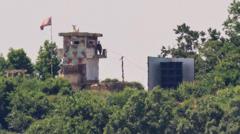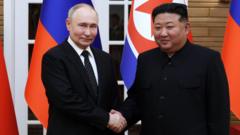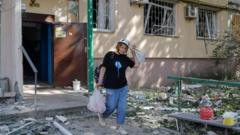Ukraine claims to have intercepted a significant portion of the assault, but the escalating assaults raise concerns over air defense capabilities.
**Intensive Russian Air Assault Strikes Ukraine in Unprecedented Scale**

**Intensive Russian Air Assault Strikes Ukraine in Unprecedented Scale**
A relentless barrage of drones and missiles hit across Ukraine, marking one of the largest aerial attacks since the war began.
In one of the most extensive overnight operations since the conflict began, Russian forces unleashed a substantial wave of drones and missiles targeting various locations in Ukraine, including the typically less affected western regions. Ukrainian authorities reported on Sunday that over 500 aerial attacks were launched, marking a record peak for a single night.
The Ukrainian Air Force disclosed that this latest offensive involved 537 deployed weapons, a figure augmented by the increased use of non-lethal decoy drones designed to mislead Ukraine’s air defenses. This tactic complicates the comparison with earlier Russian strikes, as the introduction of decoys has intensified in recent months.
Military officials noted that although approximately 90% of the deployed drones were neutralized through interception or electronic disruption, the effectiveness against missiles was less robust. Only about two-thirds of the missiles were intercepted, with significant difficulties reported against ballistic missiles, where only one out of seven was brought down.
The extent of civilian casualties resulting from the overnight assault remains unclear at this time. However, a Ukrainian Air Force pilot tragically lost his life while operating an F-16 jet in the context of repelling the aggressions. The ongoing reliance on fighter jets indicates an urgent need for more robust ground-based air defenses as the scope and intensity of Russian attacks continue to escalate.
The Ukrainian Air Force disclosed that this latest offensive involved 537 deployed weapons, a figure augmented by the increased use of non-lethal decoy drones designed to mislead Ukraine’s air defenses. This tactic complicates the comparison with earlier Russian strikes, as the introduction of decoys has intensified in recent months.
Military officials noted that although approximately 90% of the deployed drones were neutralized through interception or electronic disruption, the effectiveness against missiles was less robust. Only about two-thirds of the missiles were intercepted, with significant difficulties reported against ballistic missiles, where only one out of seven was brought down.
The extent of civilian casualties resulting from the overnight assault remains unclear at this time. However, a Ukrainian Air Force pilot tragically lost his life while operating an F-16 jet in the context of repelling the aggressions. The ongoing reliance on fighter jets indicates an urgent need for more robust ground-based air defenses as the scope and intensity of Russian attacks continue to escalate.





















